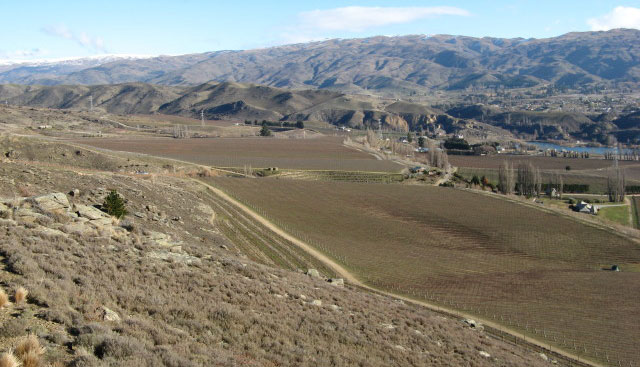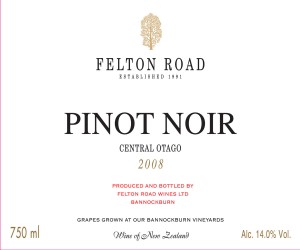New Zealand’s Central Otago-Pinot Noir In-Depth-Overview and Vertical Tasting
Links to Article Sections:
- New Zealand’s Central Otago-Pinot Noir In-Depth: Introduction
- Overview and Vertical Tasting
- Touring Central Otago’s Subregions
- Conclusion
E’ Sensual Pinot formally began on a chilly Thursday evening (this being Winter down under) with an initial overview of Central Otago, given by winemakers Matt Dicey (Mt. Difficulty) and Duncan Forsyth (Mount Edward), at the Mt. Difficulty tasting room. Much of the information I have related in the other sections of this article was covered, as well as a brief history of the region. It is remarkable to remember that as far as Pinot Noir is concerned, Central Otago is one of the newest winegrowing regions around. The first Pinot bottled here was a 1987 made by Alan Brady of Mount Edward, with Rippon following shortly thereafter. The real growth in Pinot Noir plantings in the area didn’t begin until the mid-to-late 1990’s. Thus all of the wines in the vertical tasting that followed were made from exceptionally young vines, as well as by winemakers who were just beginning to understand the unique climate and terroir of Central Otago.
At the opening meeting, the following wines from three older vintages were served. All of the wines came from the Bannockburn region, except where noted.
2000. A vintage that was dominated by the heavy rains in mid-November of 1999 that caused the flooding in Queenstown and Wanaka. December was dry then followed by a very wet January Low to moderate yields caused by very small berry size gave wines excellent concentration, and this was considered a fine vintage at the time, although still very early in Central’s history with Pinot.
I found the 2000 Akarua to be full of bright cherry fruit, a hint of leafiness, but a well-balanced wine that was smooth in texture, fairly rich, and showing some complexity. This tasted surprisingly young. Not so the 2000 Felton Road, with was quite dark, earthy, and a bit dull with some oxidation beginning to appear. Strong earthy/mushroom scents dominated the remaining fruit, which was struggling to hold on. This wine is well past its best. The 2000 Mt. Difficulty was better, with medium color and still bright fruit, although an earthy/mushroomy note dances with the black cherries. A bit low in acid and a bit stolid, the wine lacks something in terms of energy and freshness, and hasn’t gained much complexity from time in the bottle. Still sound, but this needs drinking soon.
2002. Very cold winter temperatures in 2001 were followed by an unusually early and warm spring. This was followed by a moderate summer with warm temperatures without any temperature extremes. This led to the earliest harvest date yet of March 26 at Felton Road (usually mid April). Yields were low to moderate with small berries. This is generally regarded as an outstanding vintage for the area, and the three wines we tasted certainly showed a lot more freshness and interest than the 2000’s.
The 2002 Carrick was full of rich fruit and a hint of earth, but mainly black cherry and baking spice notes; very good balance, medium body bur round and showing good maturity that fades a bit with aeration. This is ready to go and quite enjoyable. Even better was the 2002 Gibbston Valley, which shows spice, toast, ripe fruit with hints of smoke, smooth tannins, and excellent energy and verve with complexity—very nice. The 2002 Quartz Reef came from Bendigo, and the warmer climate of this region shows in the darker, more primary fruit and slightly lower acid that gives the wine a bit of a brooding aspect. Full of black fruits and great richness, this seems younger, but the wine had been poured from a magnum, which would help explain it’s apparent youth in comparison with the other wines from this vintage.
2005. Initially considered a difficult vintage for the region. Cold wet weather during late spring and early summer resulted in very low fruit set quantity in most parts of the region. Hot weather during February gave ripening a good boost along and although yields were way down the harvest dates were about normal. Although considered a challenging vintage at the time, the winemakers expressed pleasant surprise at how well the wines have developed, and this is now considered a strong vintage. The four wines served bore this out.
I really enjoyed the minerality of the 2005 Mount Edward, a bit tight with firm acidity, but great crunchy fruits like cranberries and raspberries, all shot through with mineral notes and excellent length. The 2005 Prophet’s Rock was considerably riper but not thick, with plum and black cherry fruit, round and lush in texture but supported by adequate acidity that is softer than the rest. The 2005 Surveyor Thomson was a spicier wine with hints of smoke and soy. The fruits are more cherry in nature, and there’s a touch of back-end heat, but the overall balance is good. Finally the 2005 Three Miners was a more floral wine with a hint of leafiness but decent fruit, fairly high-toned acidity that tends toward leanness, but also quite elegant. All of these wines showed a lot of class and favorable development and appear to be just entering their window of peak drinkability.
I should add a brief word about the two vintages that followed 2005, as some of these wines are still available in the U.S. 2006 was an early vintage, with early budbreak and a warm season that ripened the grapes quickly. What could have been a too-early and ripe vintage was saved by a cool March that slowed ripening and lengthened hang-time. The result was a very good year that seems to be a particular favorite of many of the winemakers of the region. 2007, on the other hand, started out cool and wet, and with frosts, all of which significantly reduced yields. The weather fortunately turned warmer in the second half of the growing season, and remained dry right through to harvest resulting in a strong vintage that most believe will be quite ageworthy. The tastings in each of the subregion would feature the 2007 vintage, so we would have our own opportunity to evaluate this vintage through a wide range of wines.
2008 Pinot Noir Tasting
The evening’s activities after our long day at Alexandra and Bendigo included a comprehensive, stand-up tasting of 32 Central Otago Pinot Noir from the 2008 vintage. 2008 was a fine vintage weather-wise, with generally warm days and cool nights, even rainfall, with a dry harvest under excellent conditions. The only drawback was large berries and a substantial yield that produced a lot of wine but perhaps at the cost of a bit of concentration. This would appear to be a user-friendly vintage of early maturing wines that will be delicious young and for the next 5 years, although perhaps not as long-lived as some other recent vintages.
This was a walk-around, stand-up tasting, so I did not take detailed notes on all of the wines. The following are short impressions the wines I found to be the most interesting and delicious (in alphabetical order, as tasted). Most of these should be available in the U.S., although distribution of many of them is very spotty.
Desert Heart: bright palate with a nicely savory, smoky fruit quality and excellent balance. find this wine
Felton Road: dark fruits, quite structured, serious and ageworthy. find this wine
Gibbston Valley: crunch fruit with significant minerality, very good balance and length. find this wine
Lowburn Ferry: delicious round fruit, very supple and rich, good depth. find this wine
Mitre Rocks: ripe but well structured with good depth and length. find this wine
Mount Edward: more open-knit style, sensuous and ripe but with good acidity, full bodied and long. find this wine
Mt. Difficulty: fairly ripe style but well balanced, fruit-forward, depth, but needs some time. find this wine
Olssens: very round, seamless, and pure, among the most complex at this young stage. find this wine
Quartz Reef: quite dark, deep with savory herbs and spice notes, voluptuous hint of sur maturite, but balanced with acidity and not too soft. find this wine
Rippon: round and complex, a textured wine of great depth and potential. find this wine
Tarras: savory with good complexity, balanced and open, for early drinking. find this wine
Two Paddocks: spicy with cherry notes and smoke, racy mouthfeel. find this wine
Based on this tasting, 2008 looks to be a fine vintage in Central Otago, although I suspect it will never get the highest rank on the areas vintage charts. It seems just a tad lighter and simpler than the immediately preceding vintages, although certainly some of this can be attributed simply to the vintage having less time to develop. The nice thing about vintages such as this, however, in addition to its early drinkability (and usefulness on restaurant wine lists), is that Central’s pinots don’t seem to lose their structural balance in less concentrated years, retaining good acidity and just enough tannic grip to give the wines shape and some depth.
This is the current vintage most widely seen in the market in New Zealand, but is just becoming more widely distributed in the U.S., where may retail and wholesale sources still seem to have plenty of ‘07’s, and even some ‘06’s available.
My overall impression is that vintages matter in Central Otago, but perhaps more in terms of the character of the wines, as opposed to their overall quality. Looking over the last decade (and with both 2009 and 2010 looking to be very strong in barrel), there really hasn’t been a poor vintage in Central Otago. The weather certainly plays a significant role in the quantity of wine available, as the region is prone to frosts and this can really do a number on yields. But overall the climate is usually dry enough, and with enough heat during the growing season, to fully ripen the grapes under good conditions, so that the risk of a dilute, moldy, or overripe vintage appears to be minimal.
With the overview and vintage review behind us, it’s time for the meat of E’Sensual Pinot—the subregional tour.
Links to Article Sections:
- New Zealand’s Central Otago-Pinot Noir In-Depth: Introduction
- Overview and Vertical Tasting
- Touring Central Otago’s Subregions
- Conclusion
Related posts:


